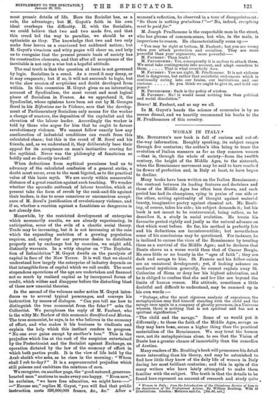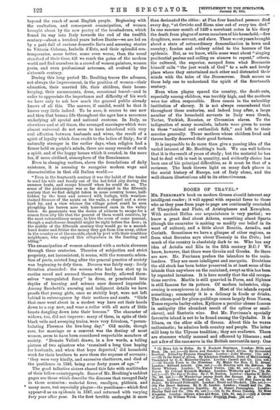WOMAN IN ITALY.*
Ma. BOULTING'S new book is full of curious and out-of- the-way information. Roughly speaking, its subject ranges through five centuries ; the author's idea being to trace the
evolution of Italian manners as far as they concern women —that is, through the whole of society—from the twelfth century, the height of the Middle Ages, to the sixteenth, when the Renaissance movement may be said to have reached its flower of perfection and, in Italy at least, to have begun to decline.
Many books have been written on the Italian Renaissance ;
the contrast between its leading features and doctrines and those of the Middle Ages has often been drawn, and each period has had its champions, vying in praise of one side or the other, setting spirituality of thought against material beauty, imaginative poetry against classical art. Mr. Bonk- hag, of course, takes his side ; his subject demands it ; but his book is not meant to be controversial, being rather, as be
describes it, a study in social evolution. He treats his favourite period rightly and justly as the natural advance on that which went before. So far, his method is perfectly fair and his deductions are incontrovertible ; but nevertheless some of his conclusions may be questioned. For instance, he is inclined to excuse the vices of the Renaissance by treating them as a survival of the Middle Ages ; and he declares that Dante shows us a worse world than that of Caesar Borgia.
He sees little or no beauty in the "ages of faith "; they are dark and savage to him. St. Francis and his fellow-saints are an unnatural development; yet, if looking askance on mediaeval mysticism generally, he cannot explain away St. Catherine of Siena or deny her his highest adfairation, and he is obliged to confess that she and her like are beyond the limits of human reason. His attitude, sometimes a little doubtful and difficult to understand, may be summed up in his own words :—
"Perhaps, after the most rigorous analysis of experience, the metaphysician may find himself standing with the child and the savage once again in a company of ghostly presences, in a Universe wherein there is nothing that is not spiritual and has not a spiritual signification."
"The child and the savage." Some of us would put it differently ; to those the faith of the Middle Ages, savage as they may have been, seems a higher thing than the practical materialism of the Renaissance. We may trust the human race, not its metaphysicians alone, to see that the Vision of Dante has a greater chance of immortality than the comedies of Aretino.
Many readers of Mr. Boulting's book will pronounce his detail more interesting than his theory, and may be astonished to find how little they know of the daily life of women in Italy during her most brilliant centuries; and this in spite of the many writers who have lately attempted to make them familiar with the subject. The truth is that the details to be found here represent an amount of research and study quite
• Woman in Italy : from the Introduction of the Chivalrous Service of Logs to the Appearance of the Professional Actrese. By William Boulting. With 18 Illustration& London : Methuen and Co. [100.8d. net.]
beyond the reach of most English people. Beginning with the exaltation, and consequent emancipation, of women brought about by the new poetry of the troubadours, which found its way into Italy towards the end of the twelfth century—about a hundred years before Dante—we are led on by a path full of curious domestic facts and amusing stories to Vittoria Cotonna, Isabella d'Este, and their splendid con- temporaries, some better, some even worse, than the usual standard of their time, till we reach the gates of the modern world and find ourselves in a crowd of women painters, women poets, and even professional actresses, all evolved by the sixteenth century.
During this long period Mr. Bonltim.7, traces the advance, not always the improvement, in the position of women—their education, their married life, their children, their house- keeping, their amusements, dress, occasional travel—and in order to appreciate the importance and difficulty of his work we have only to ask how much the general public already knows of all this. The answer, if candid, would be that it knows very little indeed. To be sure, it occurs to one now and then that human life throughout the ages has a sameness underlying all special and national customs. In Italy, as elsewhere and at all times, the arranged marriages which were almost universal do not seem to have interfered with Very real affection between husbands and wives, the result of a spirit of loyalty which does credit to the ladies of Italy; for if naturally stronger in the earlier days, when religion had a firmer hold on people's minds, there are many records of such a spirit, and of the happy homes which it created, in the more lax, if more civilised, atmosphere of the Renaissance.
Even in changing matters, above the foundations of daily existence, it is amusing to recognise modern ways and characteristics in that old Italian world:—
" Even in the fourteenth century it was the habit of the trader to send his wife and family out of the hot fetid city during the summer heats, and escape himself when he could do so. The sense of the picturesque was so far developed in the fifteenth century that we find delight taken in some country house, half- hidden by the trees and covered with leafage, with weather.. stained frescoes of the saints on the walls, a chapel and a river hard by, and a view whence the village priest could be seen ploughing his barren acre with borrowed oxen in the valley below. Se passionate was the desire of citizens to escape for a season from city life that the poorest of them would contrive, by the most extraordinary means to hire the room of some peasant, though a malodorous dunghill might be right before the door ; in the middle of the fifteenth century they would go to a second- hand dealer and fritter the money they got from him away, either in the country or at the sea-side, cheek by jowl with their wealthier neighbours, who enjoyed this vine giatura in the feasting and idling."
The emancipation of women advanced with a certain slowness through these centuries. Theories of subjection and strict propriety, not inconsistent, it seems, with the romantic adora- tion of poets, existed long after the general practice of society was beginning to defy them. Divorce was fairly easy : lively flirtation abounded: the women who had been shut up in castles roved and amused themselves freely, allowed them- selves "unregulated fancy" in dress, or penetrated into depths of learning and science once deemed impossible. Among Sacchetti's amusing and indignant details we have proofs that young girls, once so strictly kept, were not left behind in extravagance by their mothers and aunts. "Girls that once went about in a modest way have cut their hoods down to a cap now, and wear a collar with all sorts of little beasts dangling down into their bosoms." The character of widows, too, did not improve : many of them, in spite of their black veils and sweeping trains, were very frivolous, "peram- bulating Florence the live-long day." Old maids, though rare, for marriage or a convent was the destiny of most women, seem to have been considered respectable members of society. "Donato Velluti draws, in a few words, a telling picture of two spinsters who 'remained a long time hoping for husbands, and when that hope departed,' did household work for their brothers to save them the expense of servants ; they were very kindly, and excessive chatterers, and died of the pestilence in 1348, being over forty years of age.'" The good talkative sisters shared this fate with multitudes of their fellow-eountrypeople. Some of Mr. Boulting's saddest pages are those which describe the diseases that ravaged Italy in these centuries : malarial fever, smallpox, phthisis, and many more, but especially plague—the pestilence—which first appeared as an epidemic in 1347, and returned with varying fury year after year. In the first terrible onslaught it more
than decimated the cities : at Pisa four hundred persons died every day, "at Orvieto and Siena nine out of every ten died." In one summer month of 1420 a merchant notes in his diary the death from plague of seven members of his household,—five daughters, man.-servant, and slave. These worst years brought about a state of extraordinary demoralisation in town and country ; famine and robbery added to the horrors of the epidemic. But, as we know, while some went about "singing penitential psalms and calling on sinners to repent," others, the cultured, the superior, escaped from what Boccaccio himself calls "the just wrath of God" to a safe and lovely place where they entertained each other and distracted their minds with the tales of the Decanterone. Such scenes as these help one to understand the spirit of the fourteenth century.
Even when plague spared the country, the death-rate, especially among children, was terribly high, and the mothers were too often responsible. Here comes in the unhealthy institution of slavery. It is not always remembered that throughout these centuries, and indeed long after, a large number of the household servants in Italy were Greek, Tartar, Turkish, Russian, or Circassian slaves. To the indignation of many moralists, infants were given to nurse to these "animal and outlandish folk," and left to their mercies generally. Those mothers whose children lived and throve hardly deserved their good fortune.
It is impossible to do more than give a passing idea of the varied interest of Mr. Boulting's book. We can well believe that it is the result of years of study; but the material he has had to deal with is vast in quantity, and evidently choice has been one of his principal difficulties, as it must be that of a reviewer. The book throws light on many dark places in the social history of Europe, not of Italy alone, and the well-chosen illustrations add to its attractiveness.























































 Previous page
Previous page